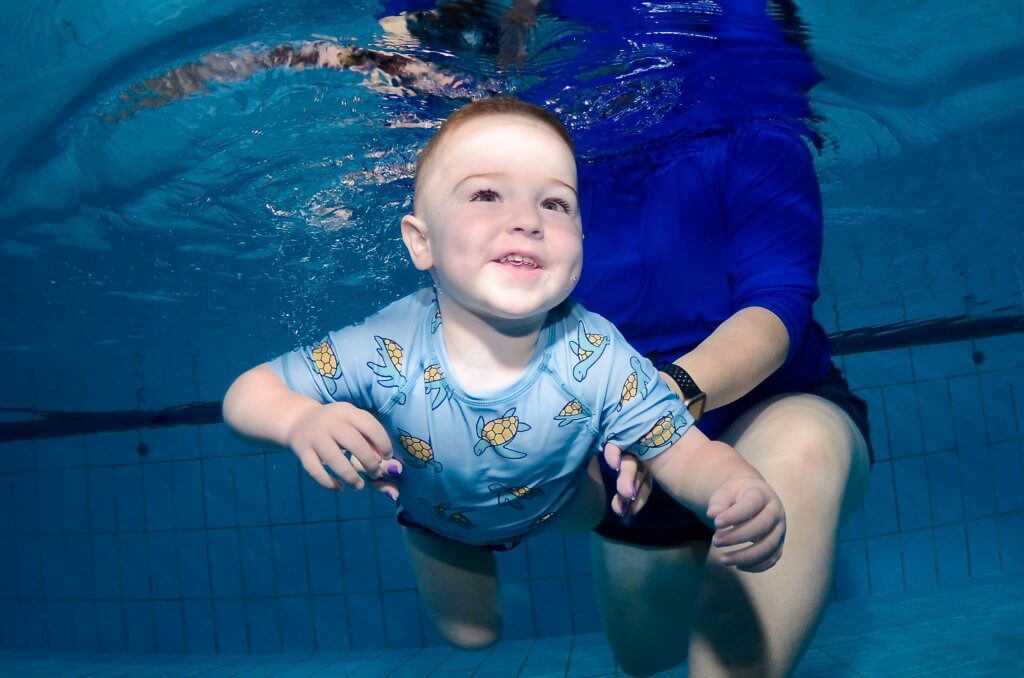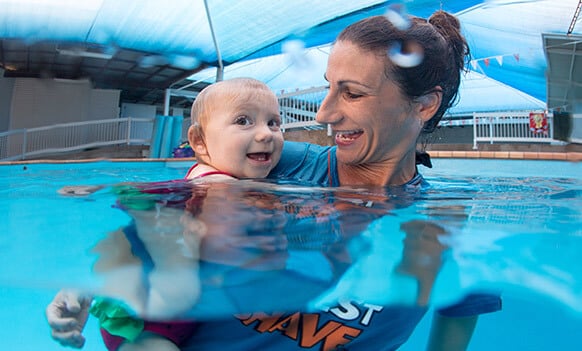When it comes to children learning to swim, it’s very important to be patient with beginner swimmers at your Swim School, and encourage them with their lessons. Swim Teachers must advise parents that they must understand the important role they play. They should regularly take their child to the pool for exploratory play, outside of the swimming lesson, and always under strict supervision. Exposing children to a variety of different situations, and depths of water, is crucial for children to learn their capabilities and boundaries.
Exploratory learning, in particular, is vital for frightened beginners. The more exposure children get to the water, the more relaxed and confident they will become. Parents will also see a faster progression for their child if they are given an opportunity to play in the water outside of the lessons. Therefore, they often perceive the lesson to be more value for money. They must become willing partners in their child’s swimming progress.

Swim School Tips for Beginning Swimmers
Developing trust in your swim school is the key with beginners. Teachers should always follow through with things that they tell their students. An example of this is when a teacher or parent tells a child in deep water, “Swim out to me, I won’t move.” Unfortunately, as soon as the child strikes out, the teacher or parent immediately move backwards, extending the child before they are ready. This very often has disastrous results – it has a big impact on the child’s confidence and progress.
Children are often reluctant to swim to an adult. This can sometimes be remedied by having the child swim to the pool’s edge, or a ledge. They are more relaxed swimming to a solid object because they know it won’t move. Once you develop trust with your beginner swimmers, they will progress quickly.

Be Consistent in Swimming Lessons
Frequently changing teachers is also detrimental for beginner swimmers; just as they gain trust in one teacher, another one is thrust upon them. If you are serious about your career as a swimming teacher you must make a commitment to attend all teaching shifts.
Water temperature will also influence children’s swimming lessons. An ideal water temperature for beginners is between 30 – 32 degrees Celsius, however, water temperature is very often outside the control of swimming teachers.
Beginner swimmers often feel the cold sooner than those students who are able to swim since they are less active. In order to remedy this, swimming teachers should plan lessons to ensure that their students are kept busy and active.
Swim school teachers who teach in situations where the water temperature is not heated, may have to begin the lesson with land drills, or water safety activities, to break up the duration of the water time. They must also keep the class moving at all times. Sometimes wave formation may be the best way to keep the whole class moving and active. They may also need to advise parents on how to appropriately dress their child to keep them warm. Encouraging children to stay down low in the water to avoid wind chill is also helpful.

Regular Routines are Helpful
Beginner learners respond positively to routines and familiar surrounds and situations. For this reason, following a similar lesson plan, from week to week, will gradually build on skills and help to progress the student faster.
Children need success in the lesson so that they feel good about themselves, and become eager to learn. The most powerful tool a teacher has in their arsenal is positive reinforcement. Giving genuine praise for attempts and triumphs will keep children interested in the lesson, and encourage them to continue to improve.
If a child is struggling with a more difficult skill, ask them to perform something simple that you know they can do, and then praise their work. This will help to build confidence, and make them willing to try a more difficult task again. Remember, teacher’s influence their students, so make sure that you influence them in a positive way. As a swimming mentor, your expertise will influence a child’s love of, and enjoyment, of the water for life.

Group Classes for Beginner Swimmers at your Swim School
Grouping children according to their ability levels will help with the smooth running of the class. Working with similar ability levels allows swim teachers to:
- Give equal attention to all students
- Control a smoother, better-balanced class
- Plan a lesson that is suitable for all
- Give maximum practice time in the lesson
- Avoid behavioural problems
If there are instances where children need to be moved to a more appropriate class, teachers should be discreet and not create a situation which may be difficult for administration. Speaking with the deck supervisor or administration prior to notifying the parent is always recommended, as this may save embarrassing the parent or child. If you first ensure that there is another suitable class available, you will safeguard against a parent or child being disappointed. Once a suitable position is found, make a big deal of the child being too good for the class, and that you need to progress him further.

Common Questions
In summary, World Wide Swim School has received a variety of questions relating to beginners over the past 7 years. We have compiled a list of 5 popular questions to share with you, and assist in delivering these lessons.
What activities should I use with first-time swimmers?
- Entries and exits in different areas of the pool
- Walking, running and jumping in shallow water
- Monkey or hand walking along the side of the pool
- Pouring water over the face using cups and watering cans
- Playing “ring a Rosie” and the class submerge together
- Floating front and back with a board
- Front and back floating for 10 seconds without a board
- Teaching children to independently recover from a floating positing
What equipment might aid the child’s learning?
- Plastic cups and watering cans
- Kickboards and noodles
- Floating mats
- Diving rings
How would you ensure maximum practice time for beginners?
- Inspect the teaching location
- Use follow the leader or wave formation
- Select an area of the pool that could assist in teaching the class eg ramp
- Identify teaching equipment that will assist delivery eg noodle, mat
- Plan the lesson remember to build swimming skills progressively
- Utilise circuits and teach children to follow the leader
- Identify class rules and expectations
- Review your lesson after your shift to adjust requirements for the following week
How would you encourage children to put their face underwater?
- Start with pouring water over the ears, back of the neck and shoulders building towards pouring water over the face
- Encourage students to pour water over their own face and allow them to pour water over you the teachers face
- Get children to put their ear underwater, lips, nose, eyebrows and of course the full face
- Use teacher and other classmates to demonstrate
- Teach children to hold their breath first, before introducing bubbles
- Use fun games like picking up rings to encourage children to put their face underwater
- Never force or hold a child’s face underwater
- Have them lie on their back in shallow water, ears submerged.
What sort of safety rules should I establish with my students?
- Make sure children learn to walk around the pool, not to dive into shallow water
- Teach children how to get in and out of the pool safely
- Make sure children learn to look and listen while you a talking
- It may be easier to have children sit outside of the pool while giving explanations
- Always use simple instructions
- Teacher personal safety rules like swimming with a buddy
- Teach basic rescue skills like sending for help, throwing an object or reaching with an object and not putting yourself in danger.
For more information on World Wide Swim School, and our packages, sign up to our monthly newsletter here.
